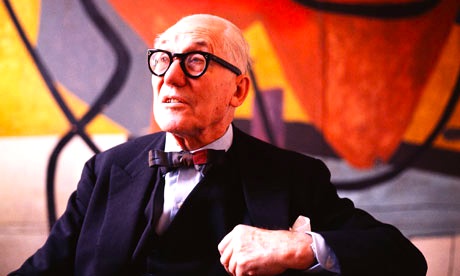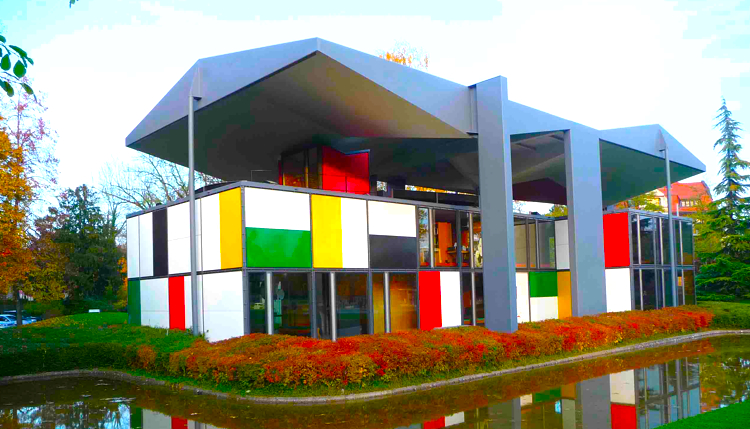By David Ross. Genocide gets plenty of publicity, and rightfully so, but there must be a word – and the attention that goes with it – for the willful annihilation of culture. It’s terrible to kill, but also terrible to sever and expunge and leave people naked and shivering in a void. Among the perpetrators of what we might call ‘civilicide’ or ‘sociocide,’ Mao is without peer, having reduced one of the great civilizations of history to childlike incapacity, to the extent that it can barely produce a readable book (so I’m told). Le Corbusier (1887-1965) ranks second to Mao, only because he desolated a narrower field of expression and did so without force. When you look at a city or a building and find it aggressively repulsive and comprehensible only in terms of self-inflicted punishment, you are almost certainly right to blame Le Corbusier.

I work in a building inspired by Le Corbusier. It is a concrete beehive that rejects windows and public meeting areas, travesties the other buildings in its vicinity, and spurns all decoration and organic flow of space in favor of the repetitive, numbing geometry of the cube. I compare this to the charming irregularity and understated delicacy of Bulfinch Hall (1818) at Phillips Academy, Andover, where I began my long dalliance with literature, seduced, perhaps, by the building itself. It was designed by Charles Bulfinch, the greatest architect of colonial Boston. The difference in the two buildings is not merely aesthetic, but functional in the largest sense. I suspect we would think better and learn better in buildings that exemplify graceful thought and mastered education. People have a way of living up to their buildings, and buildings have a way of teaching what we must live up to.
Theodore Dalrymple offers these strong words on Le Corbusier. As usual, Dalrymple is right about everything.
Posted on September 12th, 2010 at 1:06pm.

David – would you say this annihilation of culture is deliberate on the part of modernists like Le Corbusier? When one considers that he said that a house is only “a machine for living,” it’s obvious the human spirit factored little in his designs. All that mattered was the utilitarian – hence the use of poured concrete, plain square shapes, and steel beams – with no regard for what impact such a cold style may have on the human soul.
I would say this annihilation of culture was deliberate. It was the expression of a self-conscious disgust with human beings as such. Strangely enough, however, Jason has illustrated my little piece with an image of an edifice that has a certain whimsy. I would not call it a particularly appealing structure, but it does not seem characteristically nihilistic. Certainly it represents Le Corbusier in a lighter and more forgiving mood.
Is this the Centre Le Corbusier in Zurich? I think it may be. It was apparently Corbusier’s last building, perhaps an act of partial contrition. I would not want to live there (it was designed as a house), but I can understand why someone rationally might.
David – I’m not sure which Le Corbusier building this is, but to me it certainly has a lighter quality than his other work. It looks like Le Corbusier is channeling Piet Mondrian and the De Stijl style here. I’ll advise Jason to choose more dour photos to illustrate architectural atrocities in future. 🙂 You have to give Jason props though for choosing such an arrogant-looking photo of Le Corbusier – and for adding that hilarious caption “Destroyer.”
Yeah, that pic of the Zurich centre kinda undermines the point of this post…
In retrospect think I might’ve botched the picture choice on that one – I admit it. I was in a bit of a hurry. Apologies to David.
Corbusier’s architecture went through two distinct phases — I actually like the aesthetics of many of his early “Machine for Living In” white flat-roofed homes, which were built on commission for wealthy patrons in the 1920s who wanted the latest thing in design. It’s his post-war architecture, particularly his concrete apartments, which were his deadliest designs. Literally, in the sense they inspired America’s nightmarish urban renewal projects of the 1950s and 1960s, and the French regions that house the youth of no particular religious background responsible for BBQing Citroens from time to time in more recent years. Corbu’s 1920s-era patrons — the prototypes for David Brooks’ bourgeois-bohemians had a choice where they wanted to live. The poor who inhabited his apartments often didn’t.
Corbuser’s concrete work, known quite accurately as béton brut is as brutal as that phrase implies. And while some of the forms were quite interesting, from all accounts, the detailing of the work was pretty dreadful, which didn’t help living conditions. The Heidi Weber Pavilion, pictured above, was not just one of his last works, but one of the very few that Corbusier designed primarily in steel, and one of the very few of his post-war buildings that hearken back to 1920s-designs.
Dalrymple’s article on Corbusier is a brilliant demolition job; it should be read in conjunction with Tom Wolfe’s essay on “The Great Relearning,” which discusses the totalitarian impulse to junk all of mankind’s accumulated knowledge and “Start from Zero.” To build on what David wrote above, Mao, Stalin and Hitler all tried to take civilizations and “Start from Zero” — and Corbusier did the same with architecture and aesthetics, with much the same nightmarish result.
Good to see you back, Ed. Drop us a line sometime.